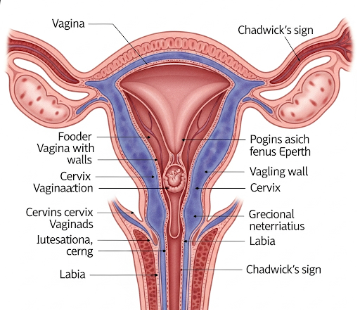Overview
Chadwick Sign is a bluish-purple discoloration of the cervix, vagina, and labia, which is an early clinical indicator of pregnancy, usually visible around 6–8 weeks of gestation. It was first described by Dr. James Chadwick in 1886.
In South Korea, obstetrics and gynecology clinics utilize this sign as part of a comprehensive early pregnancy evaluation, alongside modern tools such as ultrasound and hormonal testing, to confirm and monitor pregnancy.
Key Facts
Highlights:
➡️ Chadwick Sign appears due to increased blood flow and vascular congestion in the pelvic region.
➡️ It is considered one of the earliest observable signs of pregnancy, preceding many other physical indicators.
➡️ Visible changes usually occur around 6–8 weeks gestation.
➡️ Color change is bluish-purple, primarily in the cervix, vaginal walls, and labia.
➡️ South Korean obstetrics clinics combine traditional clinical signs with imaging for accurate early pregnancy diagnosis.
What is Chadwick Sign?
Chadwick Sign is a physiological change in the coloration of female genital tissues due to increased pelvic blood flow during pregnancy.
Key characteristics:
- Bluish-purple hue of the cervix, vagina, and labia
- Results from increased vascular congestion, secondary to elevated estrogen and progesterone levels
- Generally detectable between 6–8 weeks of gestation
- Often noted during gynecologic examination
- Useful for early pregnancy detection, especially before ultrasound confirmation
Although it is not diagnostic on its own, it serves as an important clinical clue in combination with other signs.
What Symptoms are Related to Chadwick Sign?
Chadwick Sign itself is a visual observation rather than a symptom experienced by the patient. However, it is often accompanied by early pregnancy symptoms, such as:
- Missed menstrual period
- Mild pelvic discomfort or tenderness
- Increased vaginal secretions
- Breast tenderness or swelling
- Fatigue and mild nausea
Highlights:
➡️ Chadwick Sign is observed during examination, not typically felt by the patient.
➡️ It supports other early pregnancy indicators, such as nausea, breast changes, and missed periods.
What Causes / Possible Causes of Chadwick Sign?
Highlights:
➡️ Pregnancy-Related Vascular Changes: Elevated estrogen and progesterone increase blood flow to pelvic organs, causing bluish discoloration.
➡️ Uteroplacental Blood Flow Increase: Prepares the uterus and cervix for implantation and early fetal growth.
➡️ Venous Congestion: Expansion of veins in the vagina, cervix, and labia contributes to the purple-blue hue.
➡️ Other Rare Causes: Non-pregnancy causes of bluish genital discoloration are uncommon but may include pelvic varicosities or vascular malformations.
➡️ Mechanism: Hormonal changes lead to vasodilation and increased vascularity, producing the characteristic color change.
When Should I See My Doctor?
Highlights:
➡️ If you suspect early pregnancy, a visit to a gynecologist can confirm via clinical signs and testing.
➡️ If abnormal pelvic discoloration occurs without pregnancy, evaluation is necessary to rule out vascular or pathological causes.
➡️ Routine early prenatal visits in South Korea include examination for Chadwick Sign, vital for early pregnancy monitoring.
➡️ Early consultation ensures timely care, including prenatal vitamins, lifestyle counseling, and baseline assessments.
Care and Treatment
Since Chadwick Sign is a physiological indication of pregnancy, there is no treatment required for the sign itself. Management focuses on supportive care and early pregnancy monitoring:
Highlights:
➡️ Confirm Pregnancy: Clinical examination, urine hCG testing, and early ultrasound.
➡️ Prenatal Care:
- Folic acid and vitamin supplementation
- Regular obstetric check-ups
- Lifestyle guidance (diet, exercise, avoiding harmful substances)
➡️ Monitoring: Observation of uterine growth, fetal heartbeat, and maternal health throughout early gestation.
➡️ Patient Education: Understanding early pregnancy changes, warning signs of complications, and normal physiological signs like Chadwick Sign.
Treatment Options in Korea
South Korea offers comprehensive early pregnancy care, including evaluation of Chadwick Sign:
Highlights:
➡️ Obstetrics & Gynecology Clinics: Routine early pregnancy examinations, including pelvic observation.
➡️ Advanced Ultrasound Imaging: Confirms gestational age and viability.
➡️ Prenatal Care Programs: Individualized monitoring and nutritional guidance.
➡️ Multidisciplinary Support: Collaboration between obstetricians, nutritionists, and maternal health educators.
➡️ Patient Education: Guidance on recognizing early signs, managing mild discomfort, and maintaining maternal health.
➡️ Medical Tourism Support: Multilingual consultations, early pregnancy evaluation, and follow-up care for international patients.













